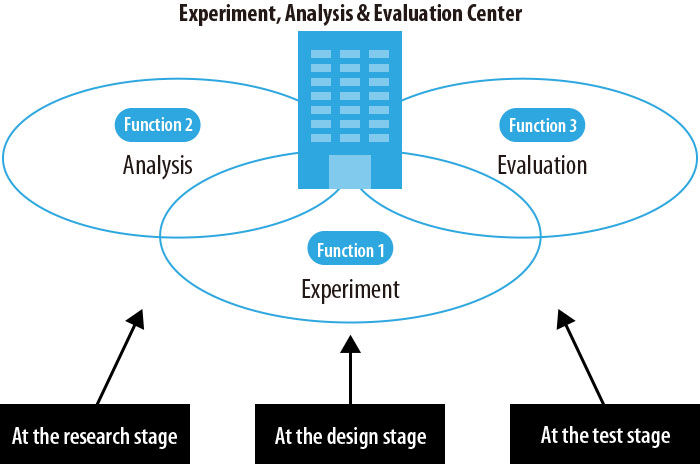Universal Design
Basic policies on universal design
The Hitachi Construction Machinery Group is embarking on the development of universal design, which facilitates easy use by anyone. This is to ensure the safety of construction machinery operators.
We are incorporating universal design in many facets. We envisage the various scenes in which out construction machinery is used and place priority on safety to create universal designs that will prevent operational errors, improve operability, and ensure comfort, among other things.
We established development and testing standards for developing universal design products by referencing ISO (2867, 6678, etc.). We have created a DR check sheet so we can confirm required items as necessary.
Development of universal design products
The prerequisite for universal design products is that they meet international standards, including ISO (2867, 6678) criteria. These standards have been reflected in all of our products. Construction machinery is not operated by a number of unspecified people but by a designated professional. Accordingly, a unique feature of this machinery is that emphasis is placed on user operability. In light of this, we implement surveys on user needs for each product and grasp specific requests which we reflect in our universal design. Newly developed universal design products are released to market after passing our own standards and an evaluation by our users.
Product development process innovation by introducing ALD
Hitachi Construction Machinery has introduced analysis lead design (ALD) that makes active use of simulation technology from the initial product development stage in order to quickly provide construction machinery that meets the diverse performance and quality demands of the global market. Having established an in-house specialized Experiment, Analysis & Evaluation Center, we are working to shorten the product development lead time and improve quality and reliability through ALD.

Using simulation analysis in the upstream development stages to reduce costs and lead time
In recent years, as the market for construction machinery has expanded, construction machinery is being used in a broader range of ways and operated in more diverse environments. For example, although the same hydraulic excavator may be used in coal mines and diamond mines, there are major differences in the hardness of the bed rock in the two mines. In addition, some construction machinery is operated in regions such as Africa and the Middle East where daytime temperatures soar to around 50°C and other machinery is used in the harsh cold of Russia and Northern Europe, where temperatures fall to -10°C. On the other hand, in some markets, such as where construction takes place in cities and residential areas, stress is placed on reduced noise and the extent that exhaust gas is filtered out of consideration of the local community.
At Hitachi Construction Machinery, we are pouring our energy into product development process innovation by introducing ALD in order to provide competitive products that meet market needs, which are becoming more diverse and advanced as discussed above, quicker and with greater certainty.
ALD is a development method for moving forward with detailed designs that reflect the results of advance evaluations of aspects such as product performance and durability through simulation analysis starting with the upstream stages of the product design process. Computer simulation analysis is already widely used in various manufacturing industries, but it has had limited impact on increasing development efficiency because it was mainly used for confirmation and verification after detail designs were created. On the other hand, it is expected that ALD will reduce costs and development lead time by eliminating rework through advance evaluations starting with upstream processes. It also has the benefit that more innovative products can be developed because it is possible to efficiently and quickly verify designs that incorporate new technologies and ideas.
Increasing the precision of advance evaluations by comparing tests with simulations
At Hitachi Construction Machinery, we have focused on the effectiveness of ALD since 3D/CAD was introduced in 1997 and have poured our energies into advance evaluations of designs using simulations. In October 2008, we launched the Experiment, Analysis & Evaluation Center, which brings together the core members responsible for various fields including analysis, evaluations, and tests at each in-house division. At the center, we have created an environment to make more effective use of ALD, including developing evaluation analysis tools and modeling technology necessary for the advance evaluation of construction machinery. On the other hand, after we complete a test product, we move forward with field tests in markets throughout the world. By repeatedly comparing and verifying simulation results against the test results of the actual machinery item and revising the analysis model, we improve the precision of advance evaluations based on simulation analysis.
Since introducing ALD, we have steadily reduced lead time and costs of product development. As the precision of and number of evaluation items of advance evaluations increase, ALD is becoming an indispensable method even when pursuing product performance and reliability.
We are introducing model-based development, which makes use of simulations in the development process, for not only hardware but also software embedded in electronic control systems, etc., and working to improve design quality, shorten development times, and reduce development costs. For example, model-based development was used when developing the embedded software for the body stability control system, which was included in recent rigid dump trucks with AC drive and has received high praise in the market.
At Hitachi Construction Machinery, we will continue to pursue more advanced development processes and construction machinery innovation by making effective use of the latest ICT.




